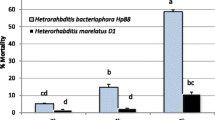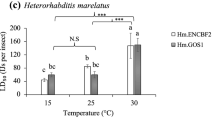Abstract
Twenty-nine Beninese isolates of Heterorhabditis sonorensis and one local isolate of H. indica were screened in bioassays for their pathogenicity against Macrotermes bellicosus and for their tolerance to heat (40 °C), desiccation (25 % glycerine) and hypoxic conditions. The bioassays showed significant differences among isolates for all tested traits. Most of the isolates (73 %) killed more than 80 % of the insects. The greatest survival of infective juveniles to heat (8 h), desiccation (8 h), and hypoxia (72 h) was observed with the H. sonorensis isolates Kassehlo (72.8 %), Setto1 (72.5 %), and Kissamey (81.5 %, respectively). Hierarchical cluster analysis identified six clusters. One of the clusters grouped three isolates of H. sonorensis (Zoundomey, Akohoun and Kassehlo) that scored well for all traits. These latter isolates were similarly effective by suppressing within five days a population of M. bellicosus naturally imprisoned in 1,000 cm3 containers and inoculated with a single two-weeks-old EPN-infected Galleria larva.


Similar content being viewed by others
References
Abbott WS (1925) A method of computing the effectiveness of an insecticide. J Econ Entomol 18:265–276
Cates J (2013) Entomopathogenic nematodes and their Enterobacteria symbionts as agents of termite control. Available via Bugs in the news vol. 02:08. http://bugsinthenews.info/?p=5767. Cited 07 Dec 2013
Ciche TA, Darby C, Ehlers R-U, Forst S, Goodrich-Blair H (2006) Dangerous liaisons: the symbiosis of entomopathogenic nematodes and bacteria. Biol Control 38:22–46
Dowds BCA, Peters A (2002) Virulence mechanisms. In: Gaugler R (ed) Entomopathogenic nematology. CABI Publishing, Wallingford, UK, pp 79–98
Fang XL, Han LR, Cao XQ, Zhu MX, Zhang X, Wang YH (2012) Statistical optimization of process variables for antibiotic activity of Xenorhabdus bovienii. PLoS ONE 7(6):e38421.
Faure P, Volkoff B (1998) Some factors affecting regional differentiation of the soils in the Republic of Benin (West Africa). Catena 32:281–306
Glazer I (2002) Survival biology. In: Gaugler R (ed) Entomopathogenic nematology. CABI Publishing, New York, USA, pp 169–187
Glazer I, Salame L (2000) Osmotic survival of the entomopathogenic nematode Steinernema carpocapsae. Biol Control 18:251–258
Grewal PS (2002) Formulation and application technology. In: Gaugler R (ed) Entomopathogenic nematology. CABI Publishing, Wallingford, UK, pp 265–287
Grewal PS, Bai XD, Jagdale GB (2011) Longevity and stress tolerance of Entomopathogenic nematodes. In: Perry RN, Wharton DA (eds) Molecular and physiological basis of nematode survival. CABI Publishing, Wallingford, UK pp 157–176
Grewal PS, Selvan S, Gaugler R (1994) Thermal adaptation of entomopathogenic nematodes: niche breadth for infection, establishment, and reproduction. J Thermal Biol 19:245–253
Grewal PS, Wang X, Taylor RAJ (2002) Dauer juvenile longevity and stress tolerance in natural populations of entomopathogenic nematodes: is there a relationship? Int J Parasitol 32:717–725
Grewal PS, Ehlers R-U, Shapiro-Ilan DI (2005) Nematodes as biocontrol agents. CABI Publishing, Wallingford, UK
Hominick WM (2002) Biogeography. In: Gaugler R (ed) Entomopathogenic nematology. CABI Publishing, Wallingford, UK, pp 115–143
Kaya HK, Stock SP (1997) Techniques in insect nematology. In: Lacey LA (ed) Manual of techniques in insect pathology. Academic Press, San Diego, USA, pp 281–324
Ma J, Chen S, Moens M, De Clercq P, Li X, Han R (2013) Characterization in biological traits of entomopathogenic nematodes isolated from North China. J Invertebr Pathol 114:268–276
Mbata GN, Shapiro-Ilan DI (2010) Compatibility of Heterorhabditis indica (Rhabditida: Heterorhabditidae) and Habrobracon hebetor (Hymenoptera: Braconidae) for biological control of Plodia interpunctella (Lepidoptera: Pyralidae). Biol Control 54:75–82
Morton A, García-del-Pino F (2009) Virulence of entomopathogenic nematodes to different stages of the flat headed root borer, Capnodis tenebrionis (L.) (Coleoptera: Buprestidae). Nematology 11:365–373
Mukuka J, Strauch O, Waeyenberge L, Viaene N, Moens M, Ehlers R-U (2010a) Heat tolerance among different strains of the entomopathogenic nematode Heterorhabditis bacteriophora. BioControl 55:423–434
Mukuka J, Strauch O, Ehlers R-U (2010b) Variability in desiccation tolerance among different strains of the entomopathogenic nematode Heterorhabditis bacteriophora. Nematology 12(5):711–720
Navon A, Ascher KRS (2000) Bioassays of entomopathogenic microbes and nematodes. CABI Publishing, Wallingford, UK
Negrisoli AS, Garcia MS, Negrisoli CRCB, Bernardi D, da Silva A (2010) Efficacy of entomopathogenic nematodes (Nematoda: Rhabditida) and insecticide mixtures to control Spodoptera frugiperda (Smith, 1797) (Lepidoptera: Noctuidae) in corn. Crop Prot 29:677–683
Patel MN, Perry RN, Wright DJ (1997) Desiccation survival and water contents of entomopathogenic nematodes Steinernema spp. (Rhabditida: Steinernematidae). Int J Parasitol 27:61–70
Poinar GO Jr, Georgis R (1989) Biological control of social insects with nematodes. In: Leslie AR, Metcalf RL (eds) Integrated pest management for turfgrass and ornamentals. U.S. Environmental Protection Agency, Washington D C, USA pp 255–269
Rouland C, Benmoussa D, Reversat G, Laumond C (1996) Étude de la sensibilité de sexués de termites Macrotermitinae à une infestation par des nématodes entomopathogènes de genres Heterorhabditis et Steinernema. C R Acad Sci Fr 319:997–1001
Shapiro DI, Glazer I, Segal D (1996) Trait stability and fitness of the heat tolerant entomopathogenic nematode Heterorhabditis bacteriophora IS5 strain. Biol Control 6:238–244
Shapiro-Ilan DI, Stuart RJ, McCoy CW (2005) Characterization of biological control traits in the entomopathogenic nematode Heterorhabditis Mexicana (MX4 strain). Biol Control 32:97–103
Shapiro-Ilan DI, Morales-Ramos JA, Rojas MG, Tedders WL (2010) Effects of a novel entomopathogenic nematode-infected host formulation on cadaver integrity, nematode yield, and suppression of Diaprepes abbreviatus and Aethina tumida. J Invertebr Pathol 103:103–108
Somasekhar N, Grewal PS, Klein MG (2002) Genetic variability in stress tolerance and fitness among natural populations of Steinernema carpocapsae. Biol Control 23:303–310
Stock SP, Rivera-Orduno B, Flores-Lara Y (2009) Heterorhabditis sonorensis n. sp. (Nematoda: Heterorhabditidae), a natural pathogen of the seasonal cicada Diceroprocta ornea (Walker) (Homoptera: Cicadidae) in the Sonoran desert. J Invertebr Pathol 100:175–184
Strauch O, Oestergaard J, Hollmer S, Ehlers R-U (2004) Genetic improvement of the desiccation tolerance of the entomopathogenic nematode Heterorhabditis bacteriophora through selective breeding. Biol Control 31:218–226
Zadji L, Baimey H, Afouda L, Houssou FG, Waeyenberge L, De Sutter N, Moens M, Decraemer W (2013) First record on the distribution of entomopathogenic nematodes (Rhabditida: Steinernematidae and Heterorhabditidae) in Southern Benin. Russ J Nematol 21(1):117–130
Zadji L, Baimey H, Afouda L, Moens M, Decraemer W (2014) Effectiveness of different Heterorhabditis isolates from Southern Benin for biocontrol of the subterranean termite, Macrotermes bellicosus (Isoptera: Macrotermitinae), in laboratory trials. Nematology 16:109–120
Acknowledgments
The first author highly acknowledges the Belgian Government and VLIR-UOS Institutional University cooperation, for providing a PhD scholarship within the VLIR-UOS Own Initiative project.
Author information
Authors and Affiliations
Corresponding author
Additional information
Handling Editor: Ralf Ehlers.
Rights and permissions
About this article
Cite this article
Zadji, L., Baimey, H., Afouda, L. et al. Characterization of biocontrol traits of heterorhabditid entomopathogenic nematode isolates from South Benin targeting the termite pest Macrotermes bellicosus . BioControl 59, 333–344 (2014). https://doi.org/10.1007/s10526-014-9568-9
Received:
Accepted:
Published:
Issue Date:
DOI: https://doi.org/10.1007/s10526-014-9568-9




